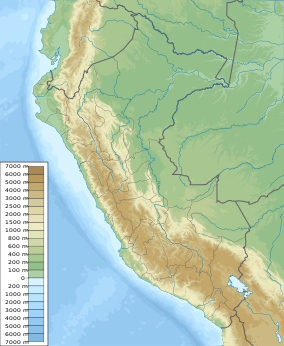| Pampa Hermosa National Sanctuary | |
|---|---|
| Location | Junín Region |
| Coordinates | 11°02′12″S 75°28′50″W / 11.03667°S 75.48056°W |
| Area | 11543,74 ha |
| Established | 2005 |
| Governing body | SERNANP |
Pampa Hermosa National Sanctuary (Spanish: Santuario Nacional Pampa Hermosa) is a protected area in Peru located in the region of Junín.[1] It preserves one of the last pristine areas of montane forests in central Peru.[1]
YouTube Encyclopedic
-
1/2Views:3 794324
-
Tiempo de viaje - Pampa Hermosa
-
Best Cheapest Santa Teresa Hotels Costa Rica for vacation and travel
Transcription
Geography
Pampa Hermosa National Sanctuary is located between the provinces of Tarma and Chanchamayo, in the region of Junin, Peru.[2] The area is mountainous, with an elvational range between 1340 and 3960 m.[2]
Ecology
Pampa Hermosa protects areas of tropical montane rainforests and high elevation grasslands.[2]
Flora
Plant species found in this protected area include: Cedrela angustifolia, Juglans neotropica, Retrophyllum rospigliosii, Iriartea deltoidea, Weinmannia sp., Escallonia myrtilloides, Pseudolmedia rigida, Alnus acuminata, Prumnopitys montana, Guarea guidonia, Styrax andinus, etc.[1][3][2]
Fauna
Animal species found in this protected area include: the Andean cock-of-the-rock, the Junín red squirrel, the yellow-throated toucan, the spectacled bear, the semicollared hawk, etc.[1][2]
References
- ^ a b c d "Pampa Hermosa - Servicio Nacional de Áreas Naturales Protegidas por el Estado". www.sernanp.gob.pe (in European Spanish). Retrieved 2018-11-14.
- ^ a b c d e Santuario Nacional Pampa Hermosa. Diagnóstico - Plan Maestro 2012-2017. SERNANP. 2014. ISBN 978-612-4241-01-7.
- ^ La Torre-Cuadros, María De Los Ángeles; Herrando-Pérez, Salvador; Young, Kenneth R. (2007). "Diversity and structural patterns for tropical montane and premontane forests of central Peru, with an assessment of the use of higher-taxon surrogacy". Biodiversity and Conservation. 16 (10): 2965–2988. doi:10.1007/s10531-007-9155-9. ISSN 0960-3115. S2CID 40800425.

